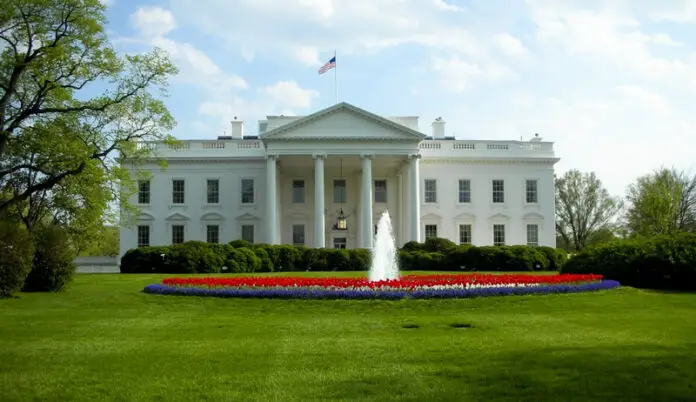President Donald Trump abruptly ejected a White House staffer from the Oval Office on August 25, 2025, after a phone noise interrupted his remarks during an executive order signing ceremony. The incident occurred while Trump was addressing reporters about his decision to purchase a portion of Intel stock on behalf of the United States government.
The disruption happened as Trump was mid-sentence, responding to a journalist’s question about the stock market performance. Trump had begun stating that the stock market had risen almost 1,000 points on Friday when he stopped abruptly. Trump asked, “Hello, who is that? Who is that back there? Alright, get out of the room!”
Multiple news outlets identified the dismissed staffer as Will Scharf, the White House staff secretary responsible for handling Trump’s executive orders during signing ceremonies. Scharf, who previously served as one of Trump’s personal attorneys and was an unsuccessful candidate for Missouri attorney general, typically explains the importance of each directive to the president during these events.
The Daily Mail confirmed that Scharf was standing next to Trump, handling documents for signing just moments before the incident occurred. Reports indicated that either a noisy cell phone or the opening of a door while Trump was addressing the conference triggered the president’s reaction. Following Trump’s directive, laughter was heard from cabinet members present in the room before an Oval Office door slammed shut.
This incident represents a pattern of behavior for Trump, who has demonstrated limited patience for distractions during official proceedings. In June 2019, Trump similarly dismissed his acting chief of staff Mick Mulvaney from the Oval Office during a live television interview with ABC News’ George Stephanopoulos. During that interview, Trump directed Mulvaney to leave after he coughed while the president was speaking, telling him that if he was going to cough, he should leave the room.
The August 25 ceremony was part of a lengthy Oval Office session where Trump signed multiple executive orders. During this same event, observers noted that Trump appeared to have bruising on his hand, which has previously been attributed by White House officials to frequent handshaking and his use of aspirin as part of a cardiovascular prevention regimen. The White House physician had previously diagnosed Trump with chronic venous insufficiency in July, describing it as a benign and common condition for individuals over 70.
Scharf plays a crucial role in Trump’s administration as the staff member who manages the physical copies of executive orders and explains their significance during signing ceremonies. Before joining the new administration, he was a member of Trump’s legal team. The Economic Times described Scharf as Trump’s “executive order guru” due to his central role in these proceedings.
The incident occurred during Trump’s response to questions about his administration’s decision to purchase a stake in Intel Corporation for the federal government. The president had been discussing the stock market’s performance, specifically mentioning the nearly 1,000-point increase that had occurred the previous Friday, when the interruption forced him to halt his remarks.
Video footage of the incident circulated on social media, showing the moment Trump stopped speaking and addressed the disruption before ordering the staffer to leave. The footage captured the president maintaining a serious expression while others in the room responded with laughter to the unexpected interruption.
The Oval Office signing ceremony was part of Trump’s ongoing efforts to implement his policy agenda through executive action. These events typically feature multiple cabinet members and staff members, with Scharf playing a central role in managing the documentation and ensuring the president understands each order before signing.
In purchasing Intel stock, the Trump administration’s decision to take an equity share in the company marks a major break from long-standing U.S. economic norms. For the first time, the federal government has bought stock in a major private corporation not as a response to a crisis, but for strategic reasons.
The acquisition involved roughly 10% of Intel’s common shares through an $8.9 billion investment, combining $5.7 billion from earlier CHIPS Act funding with $3.2 billion from the Secure Enclave program.
This step departs from decades of free-market practice in which Washington typically supported private industry through grants, loans, or contracts rather than becoming a direct shareholder. Unlike the stakes taken during the 2008 financial crisis to rescue struggling firms like General Motors and major banks, the Intel deal is a proactive national security move aimed at strengthening a robust, strategically vital company at the heart of U.S. semiconductor manufacturing.
The arrangement could benefit both Intel and taxpayers. Instead of offering grants that are simply spent, the government’s ownership stake may generate returns if Intel’s stock price rises. For Intel, the investment provides substantial capital without the many strings attached to traditional federal aid, while advancing the nation’s goal of reducing dependence on foreign chip production and securing domestic capacity in advanced semiconductor manufacturing.
Politically, the deal is especially significant in Ohio, where Intel is building major fabrication plants ahead of the 2026 Senate races.
More broadly, the investment signals a shift toward a more active industrial strategy, moving the U.S. closer to the state-supported models of countries like South Korea and Taiwan, which have fostered their own technology leaders. It also serves as a strategic counter to China’s extensive subsidies for its semiconductor industry, as the U.S. seeks to maintain its technological leadership in a critical global sector.

